一. 模式探究
1.背景
在一些输入受限的设备上,要完成用户名和口令的输入是非常困难的,设备授权模式,可让用户登录到智能电视、 IoT 物联网设备或打印机等输入受限的设备。 若要启用此流,设备会让用户在另一台设备上的浏览器中访问一个网页,以进行登录。 用户登录后,设备可以获取所需的访问令牌和刷新令牌。
2.运行流程
图一:
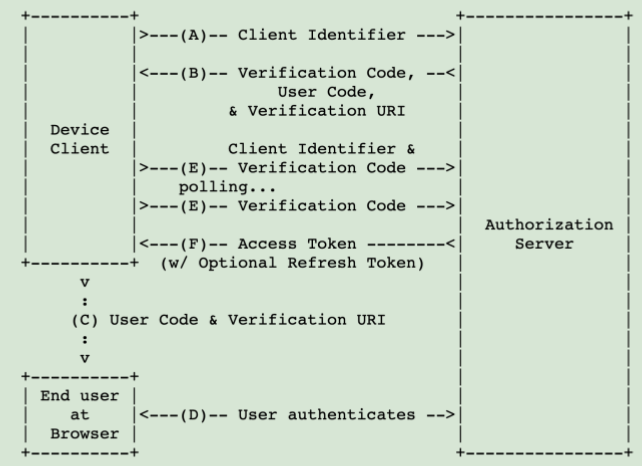
图二:
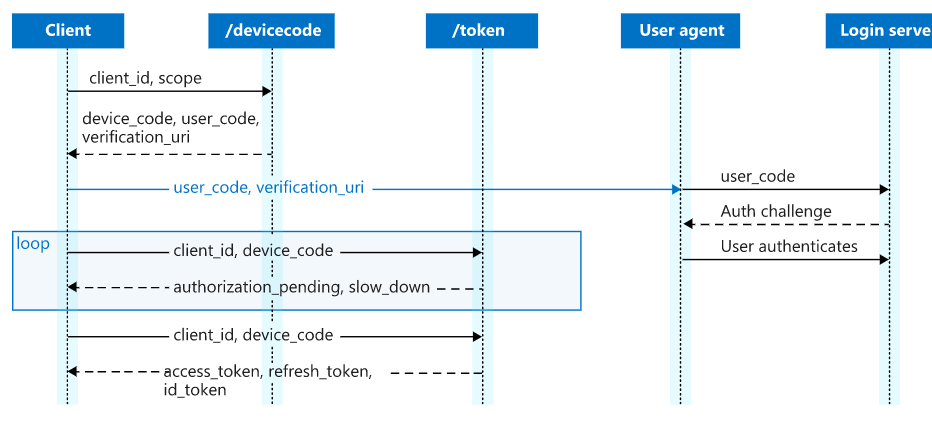
大致流程:
1. 客户端通过携带ClientId、ClientSecret,请求IDS4服务器,请求成功,返回:DeviceCode、VerificationUriComplete
2. 客户端将url写入二维码,或者用浏览器直接打开,进入授权页面。这期间,客户端携带ClientId、ClientSecret、DeviceCode不断轮询请求IDS4服务器,看是否已经授权。
3. 上面的授权页面,用户输入账号、密码,确认授权。
4. 客户端通过轮询得知已经授权,且拿到返回值 accessToken。
5. 客户端携带accessToken,请求资源服务器。
参考:
微软OAuth 2.0 设备代码流:https://docs.microsoft.com/zh-cn/azure/active-directory/develop/v2-oauth2-device-code
百度Device授权模式:https://developer.baidu.com/wiki/index.php?title=docs/oauth/device
IDS4代码参考:https://damienbod.com/2019/02/20/asp-net-core-oauth-device-flow-client-with-identityserver4/
二. 代码实操与剖析
1. 项目准备
(1). IDS4_Server2: 授权认证服务器
(2). ResourceServer: 资源服务器
(3). WinformClient1:基于winform的客户端 (.Net下的,非Core下)
2.搭建步骤
(一).IDS4_Server2
(1).通过Nuget安装【IdentityServer4 4.0.2】程序集
(2).集成IDS4官方的UI页面
进入ID4_Server2的根目录,cdm模式下依次输入下面指令,集成IDS4相关的UI页面,发现新增或改变了【Quickstart】【Views】【wwwroot】三个文件夹
A.【dotnet new -i identityserver4.templates】
B.【dotnet new is4ui --force】 其中--force代表覆盖的意思, 空项目可以直接输入:【dotnet new is4ui】,不需要覆盖。
PS. 有时候正值版本更新期间,上述指令下载下来的文件可能不是最新的,这个时候只需要手动去下载,然后把上述三个文件夹copy到项目里即可
(下载地址:https://github.com/IdentityServer/IdentityServer4.Quickstart.UI)
(3).创建配置类 Config1
A.配置api的范围集合:ApiScope, 在4.x版本中必须配置
B.配置需要保护Api资源:ApiResource,每个resource后面都需要配置对应的Scope
C.配置可以访问的客户端资源:Client。重点配置设备流模式:GrantTypes.DeviceFlow。
D.配置可以访问的用户资源:TestUser
代码分享:

public class Config1 { /// <summary> /// 声明api的Scope(范围)集合 /// IDS4 4.x版本必须写的 /// </summary> /// <returns></returns> public static IEnumerable<ApiScope> GetApiScopes() { List<ApiScope> scopeList = new List<ApiScope>(); scopeList.Add(new ApiScope("ResourceServer")); return scopeList; } /// <summary> /// 定义需要保护的Api资源 /// </summary> /// <returns></returns> public static IEnumerable<ApiResource> GetApiResources() { List<ApiResource> resources = new List<ApiResource>(); //ApiResource第一个参数是ServiceName,第二个参数是描述 resources.Add(new ApiResource("ResourceServer", "ResourceServer服务需要保护哦") { Scopes = { "ResourceServer" } }); return resources; } /// <summary> /// 定义可以使用ID4 Server 客户端资源 /// </summary> /// <returns></returns> public static IEnumerable<Client> GetClients() { List<Client> clients = new List<Client>() { new Client { ClientId = "client1",//客户端ID AllowedGrantTypes = GrantTypes.DeviceFlow, //验证类型:设备流模式 RequireConsent = true, //手动确认授权 ClientSecrets ={ new Secret("0001".Sha256())}, //密钥和加密方式 AllowedScopes = { "ResourceServer" }, //允许访问的api服务 AlwaysIncludeUserClaimsInIdToken=true } }; return clients; } /// <summary> /// 定义可以使用ID4的用户资源 /// </summary> /// <returns></returns> public static List<TestUser> GetUsers() { var address = new { street_address = "One Hacker Way", locality = "Heidelberg", postal_code = 69118, country = "Germany" }; return new List<TestUser>() { new TestUser { SubjectId = "001", Username = "ypf1", //账号 Password = "123456", //密码 Claims = { new Claim(JwtClaimTypes.Name, "Alice Smith"), new Claim(JwtClaimTypes.GivenName, "Alice"), new Claim(JwtClaimTypes.FamilyName, "Smith"), new Claim(JwtClaimTypes.Email, "AliceSmith@email.com"), new Claim(JwtClaimTypes.EmailVerified, "true", ClaimValueTypes.Boolean), new Claim(JwtClaimTypes.WebSite, "http://alice.com"), new Claim(JwtClaimTypes.Address, JsonSerializer.Serialize(address), IdentityServerConstants.ClaimValueTypes.Json) } }, new TestUser { SubjectId = "002", Username = "ypf2", Password = "123456", Claims = { new Claim(JwtClaimTypes.Name, "Bob Smith"), new Claim(JwtClaimTypes.GivenName, "Bob"), new Claim(JwtClaimTypes.FamilyName, "Smith"), new Claim(JwtClaimTypes.Email, "BobSmith@email.com"), new Claim(JwtClaimTypes.EmailVerified, "true", ClaimValueTypes.Boolean), new Claim(JwtClaimTypes.WebSite, "http://bob.com"), //这是新的序列化模式哦 new Claim(JwtClaimTypes.Address, JsonSerializer.Serialize(address), IdentityServerConstants.ClaimValueTypes.Json) } } }; } }
(4).在Startup类中注册、启用、修改路由
A.在ConfigureService中进行IDS4的注册.
B.在Configure中启用IDS4 app.UseIdentityServer();
C.路由,这里需要注意,不要和原Controllers里冲突即可,该项目中没有Controllers文件夹,不要特别配置。
代码分享:

public class Startup { public Startup(IConfiguration configuration) { Configuration = configuration; } public IConfiguration Configuration { get; } // This method gets called by the runtime. Use this method to add services to the container. public void ConfigureServices(IServiceCollection services) { services.AddControllersWithViews(); services.AddIdentityServer() .AddDeveloperSigningCredential() //生成Token签名需要的公钥和私钥,存储在bin下tempkey.rsa(生产场景要用真实证书,此处改为AddSigningCredential) .AddInMemoryApiScopes(Config1.GetApiScopes()) //存储所有的scopes .AddInMemoryApiResources(Config1.GetApiResources()) //存储需要保护api资源 .AddTestUsers(Config1.GetUsers()) //存储用户信息 .AddInMemoryClients(Config1.GetClients()); //存储客户端模式(即哪些客户端可以用) } // This method gets called by the runtime. Use this method to configure the HTTP request pipeline. public void Configure(IApplicationBuilder app, IWebHostEnvironment env) { if (env.IsDevelopment()) { app.UseDeveloperExceptionPage(); } else { app.UseExceptionHandler("/Home/Error"); } app.UseStaticFiles(); app.UseRouting(); //启用IDS4 app.UseIdentityServer(); app.UseAuthorization(); app.UseEndpoints(endpoints => { endpoints.MapControllerRoute( name: "default", pattern: "{controller=Home}/{action=Index}/{id?}"); }); } }
(5).配置启动端口,直接设置默认值: webBuilder.UseStartup<Startup>().UseUrls("http://127.0.0.1:7000");
(6).修改属性方便调试:项目属性→ 调试→应用URL(p),改为:http://127.0.0.1:7000 (把IISExpress和控制台启动的方式都改了,方便调试)
图:
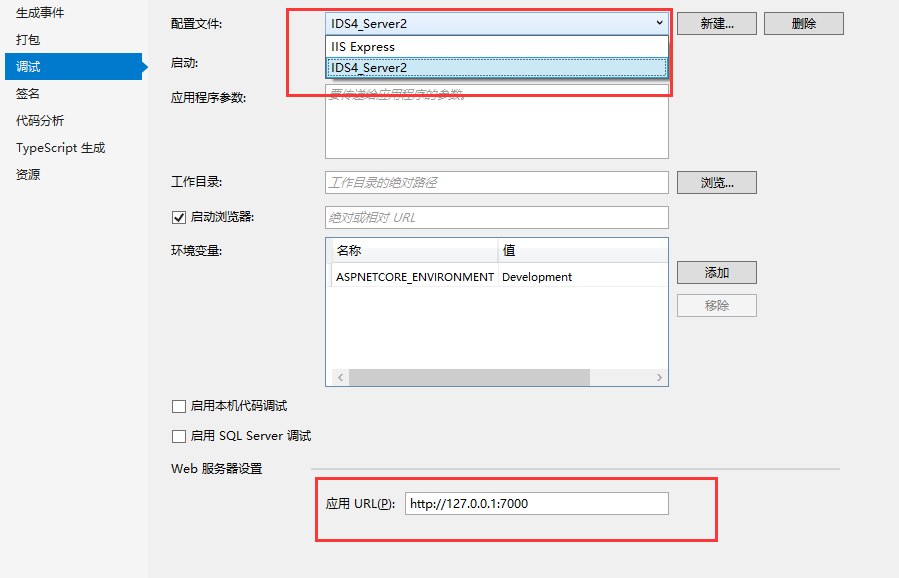
(二).ResourceServer
(1).通过Nuget安装 【IdentityServer4.AccessTokenValidation 3.0.1】
(2).在ConfigureService通过AddIdentityServerAuthentication连接ID4服务器,进行校验,使用的是Bear认证方式。这里ApiName中的“ResourceServer”必须是ID4中GetApiResources中添加的。
特别注意:这个Authority要用127.0.0.1, 不用Localhost,因为我们获取token的时候,使用的地址也是127.0.0.1,必须对应起来.
(3).在Config中添加认证中间件 app.UseAuthentication();
代码分享:

public class Startup { public Startup(IConfiguration configuration) { Configuration = configuration; } public IConfiguration Configuration { get; } // This method gets called by the runtime. Use this method to add services to the container. public void ConfigureServices(IServiceCollection services) { services.AddControllers(); //校验AccessToken,从身份校验中心(IDS4_Server2)进行校验 services.AddAuthentication(IdentityServerAuthenticationDefaults.AuthenticationScheme) //Bear模式 .AddIdentityServerAuthentication(options => { options.Authority = "http://127.0.0.1:7000"; // 1、授权中心地址 options.ApiName = "ResourceServer"; // 2、api名称(项目具体名称) options.RequireHttpsMetadata = false; // 3、https元数据,不需要 }); } // This method gets called by the runtime. Use this method to configure the HTTP request pipeline. public void Configure(IApplicationBuilder app, IWebHostEnvironment env) { if (env.IsDevelopment()) { app.UseDeveloperExceptionPage(); } app.UseRouting(); //认证中间件(服务于上ID4校验,一定要放在UseAuthorization之前) app.UseAuthentication(); app.UseAuthorization(); app.UseEndpoints(endpoints => { endpoints.MapControllers(); }); } }
(4).新建一个GetMsg接口,并加上特性[Authorize]。
代码分享:

[Route("api/[controller]/[action]")] [ApiController] public class HomeController : ControllerBase { /// <summary> /// 资源服务器的api /// </summary> /// <returns></returns> [Authorize] [HttpGet] public string GetMsg() { //快速获取token的方式 string token = HttpContext.GetTokenAsync("access_token").Result; return $"ypf"; } }
(5).配置启动端口,直接设置默认值: webBuilder.UseStartup<Startup>().UseUrls("http://127.0.0.1:7001");
(6).修改属性方便调试:项目属性→ 调试→应用URL(p),改为:http://127.0.0.1:7001 (把IISExpress和控制台启动的方式都改了,方便调试)
图:
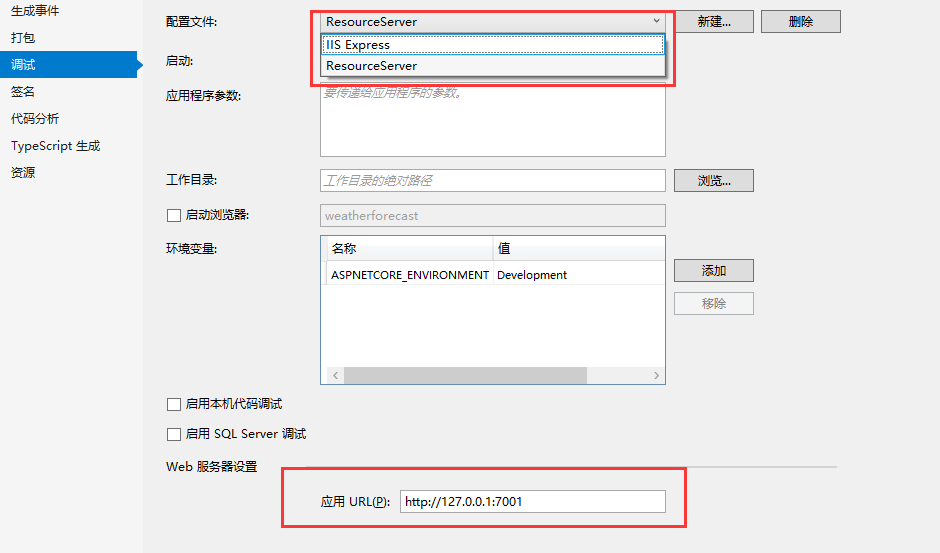
(三).WinformClient1
(1).通过Nuget安装【QRCoder 1.3.9】 【IdentityModel 4.3.0】
(2).请求IDS4服务器,拿到一个url,写入二维码,并显示二维码;客户端此时在轮询请求IDS4,看是否已经授权成功。
(3).正常应该用手机扫描二维码,进行授权,这里为了方便演示, 用浏览器直接打开这个地址,代替手机扫描
eg:Process.Start(new ProcessStartInfo(deviceResponse.VerificationUriComplete) { UseShellExecute = true });
(4).授权成功后,客户端拿着返回的accessToken,继续请求api资源服务器,请求成功
代码分享:

} private async void Form1_Load(object sender, EventArgs e) { var client = new HttpClient(); var disco = await client.GetDiscoveryDocumentAsync("http://127.0.0.1:7000"); //IDS4服务器 var deviceResponse = await client.RequestDeviceAuthorizationAsync(new DeviceAuthorizationRequest { Address = disco.DeviceAuthorizationEndpoint, ClientId = "client1", ClientSecret = "0001" }); //生成二维码 CreateQrCode(deviceResponse.VerificationUriComplete); //通过浏览器打开地址 Process.Start(new ProcessStartInfo(deviceResponse.VerificationUriComplete) { UseShellExecute = true }); //轮询请求 string accessToken; while (true) { // request token var tokenResponse = await client.RequestDeviceTokenAsync(new DeviceTokenRequest { Address = disco.TokenEndpoint, ClientId = "client1", ClientSecret = "0001", DeviceCode = deviceResponse.DeviceCode }); if (!tokenResponse.IsError) { accessToken = tokenResponse.AccessToken; break; } await Task.Delay(TimeSpan.FromSeconds(deviceResponse.Interval)); //await Task.Delay(TimeSpan.FromSeconds()); } await CallApiAsync(accessToken); } /// <summary> /// 请求api资源 /// </summary> /// <param name="token"></param> /// <returns></returns> private async Task CallApiAsync(string token) { // call api var apiClient = new HttpClient(); apiClient.SetBearerToken(token); var response = await apiClient.GetAsync("http://127.0.0.1:7001/api/Home/GetMsg"); if (!response.IsSuccessStatusCode) { var msg= response.Content.ReadAsStringAsync().Result; this.pictureBox1.Visible = false; //隐藏二维码 this.label2.Text = msg; //显示返回结果 //MessageBox.Show($"api返回值为:{msg}"); } else { var msg = response.Content.ReadAsStringAsync().Result; this.pictureBox1.Visible = false; //隐藏二维码 this.label2.Text = msg; //显示返回结果 //MessageBox.Show($"api返回值为:{msg}"); } } /// <summary> /// 生成二维码 /// </summary> /// <param name="verificationUriComplete"></param> public void CreateQrCode(string verificationUriComplete) { QRCodeGenerator qrGenerator = new QRCodeGenerator(); QRCodeData qrCodeData = qrGenerator.CreateQrCode(verificationUriComplete, QRCodeGenerator.ECCLevel.Q); QRCode qrCode = new QRCode(qrCodeData); Bitmap qrCodeImage = qrCode.GetGraphic(6); this.pictureBox1.Image = Image.FromHbitmap(qrCodeImage.GetHbitmap()); }
窗体:
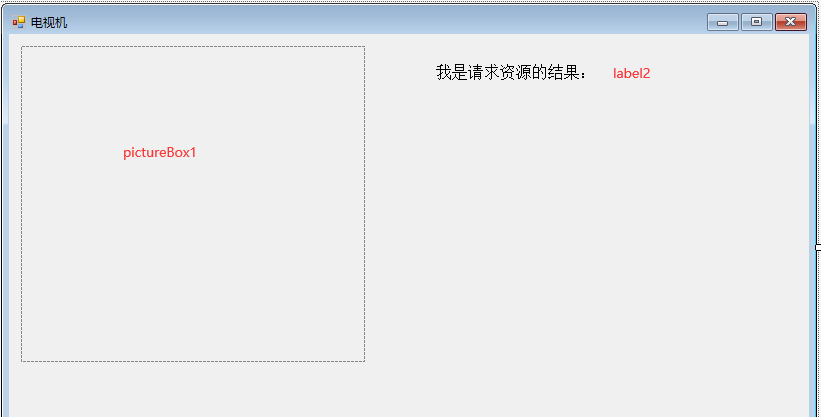
PS:详细的流程剖析详见下面的剖析测试
3.剖析测试
测试过程如下:
(PS:不知为啥fiddler捕捉不到winfrom发送的http请求,这里只能通过截图来说明了)

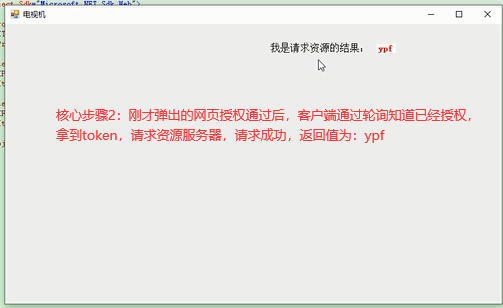
!
- 作 者 : Yaopengfei(姚鹏飞)
- 博客地址 : http://www.cnblogs.com/yaopengfei/
- 声 明1 : 如有错误,欢迎讨论,请勿谩骂^_^。
- 声 明2 : 原创博客请在转载时保留原文链接或在文章开头加上本人博客地址,否则保留追究法律责任的权利。
